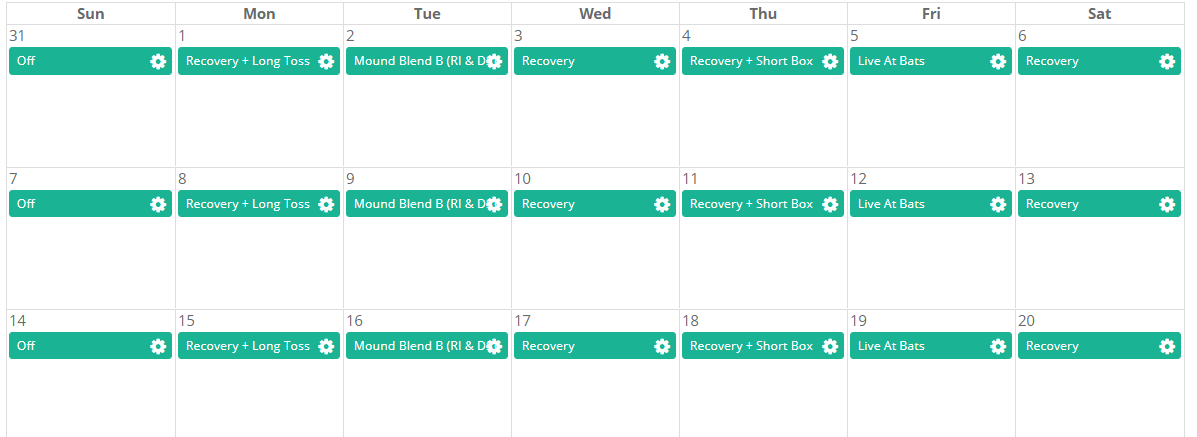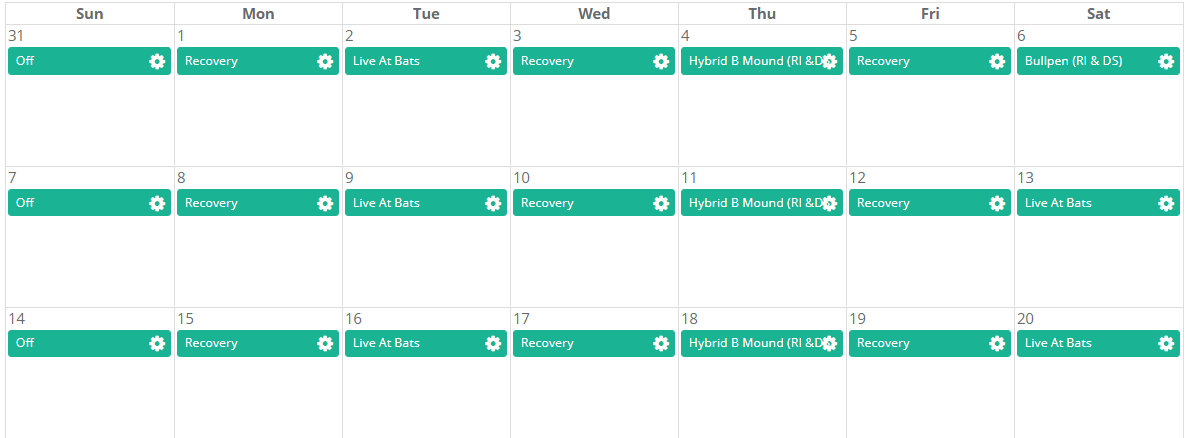Pitching Programming, Part 2: Competition Phases (Starters vs Relievers)

Welcome to Part 2 of our programming strategies blog series. If you missed Part 1, you can check it out here. Today’s topic will cover programming strategies for pitchers during a competition phase.
All successful pitching coaches are proficient in a variety of topics. These may include but are not limited to building a strong coach-player rapport, pitch design, skill acquisition, basic analytics, mechanics, and strength and conditioning. Moreover, it is crucial for a pitching coach to appreciate each role within their staff and the inherent training demands of each position.
Here we are going to discuss training in a competition phase—when a pitcher’s projected role within the staff has a significant impact on his training structure. A competition phase is a training cycle that typically leads directly into gameplay. This is when the athlete’s focus needs to shift from a training mindset to a results mindset. At this time, the primary focus usually centers around fine-tuning his arsenal through bullpens and dominating hitters in Live ABs.
Based on a pitcher’s projected role within the staff, each player’s competition phase may be slightly different. Let’s dive into some of those differences!
Weekend Starters
The first role we will cover is starters. The competition phase goal for this role is to be ready to throw 6+ innings come opening weekend. We can accomplish this by structuring their training week around their high intent day. From a workload perspective, these high intent days would be bullpens or live ABs thrown at high volume, high intensity, but low frequency (about once per week).
A good first step for creating a weekly plan for starters is to communicate what probable day (or game, if throwing in a doubleheader) they will pitch. You can then discuss what they feel they need to do each week to be ready for game day. This may include a mid-week bullpen with long toss, short box with long toss, velocity day, etc. This discussion will then paint a good picture of how their weekly plan will look, and allow them to develop a routine weeks before opening day.
Here is an example of a three-week TRAQ plan for a Friday night conference starter who likes to have a mid-week low effort bullpen and a short box mixed in:
For this example, you can gradually increase the number of innings this pitcher will throw each Live AB session. This should get him ready for a handful of innings of work on opening day.
Mid-week Starters
The next role we will cover is mid-week starters. Unlike conference starters, these pitchers can throw several innings during the week, in addition to a weekend relief appearance. This hybrid role requires a slightly different approach when structuring their weekly plan. They need to be able to handle high intent days at a moderate volume, high intensity, and moderate frequency (about twice per week).
Similar to conference starters, I think it is always helpful if these pitchers have a rough idea of what game they will get the ball. We can then structure their weekly plan around their start date, and then account for their potential relief appearance after. Here is an example of a three-week plan for a mid-week (say Tuesday) starter who must be ready to pitch in relief during conference play:
For this example, this pitcher’s high volume, high intent day would be Tuesday, as it reflects him starting. By the end of week three, we can gradually progress him to throwing up to four innings on Tuesday and one-two innings on Saturday.
Relievers
The last role we will cover is relievers. In contrast to the previous roles, these pitchers must be capable of making several appearances over the week, some lasting 3+ outs. Their weekly plan should reflect this demand. They need to be able to handle high intent days at a low volume, yet be prepared for high intensity and high frequency (up to three per week).
An often overlooked aspect when preparing relievers for opening day is the proximity of high intent days within the week. This means it is important for relievers to be prepared to throw an inning two days (sometimes even three days) in a row. Here is an example of a three-week plan for a reliever who must be ready to pitch two days in a row come opening day.
We can purposely position high intent days closer to each other as the weeks progress. As long as pitch limits are set, I think there is a lot of value in doing this, as it prepares them to pitch on minimal to no rest.
Furthermore, I think incorporating a “get hot quick” routine or drill into their competition phase is absolutely invaluable! It is inevitable that we will need one of our relievers to enter a game with minimal notice. Why not have our relievers practice this heading into opening day? I remember listening to Justin James, current HC at Point Loma Nazarene University, give a presentation on this topic at ABCA.
He was discussing some things he implemented with their pitchers, including this idea of a “get hot quickly” drill. I loved the idea and implemented it into our preseason at Lake Erie College. All credit goes to Coach James! Essentially, the drill works like this:
- Have a relief pitcher follow his normal warm-up routine (dynamic warm-up, J bands, shoulder tube, wrist weights, Plyo Ball ®, etc.).
- Then have him wait for X amount of minutes (could be 10, 15, 20, 30+). Instruct him that he can do anything he wants to stay warm, so long as he can do it in the bullpen during a game.
- When the time comes, call his name and give him about 2-2.5 minutes to get hot, simulating as if he’s going in a game.
During the latter half of our preseason at LEC, I implemented this with our relievers. I had a goal for each reliever to complete this drill at least twice before opening day. I felt the drill was even more effective when done outside, as it gave pitchers experience warming up during the cold spring in northeast Ohio.
In conclusion, there is no doubt that the competition phase is a crucial aspect of the typical training calendar of a pitcher. A properly structured program must take into account the pitcher’s projected role in the staff and the inherent demands of each role. As coaches, the better we can prepare our pitchers for opening day, the higher chance we’ll give our staff to succeed.
Thanks for reading! Stay tuned for Part 3!
By Stephen Hart



Comment section